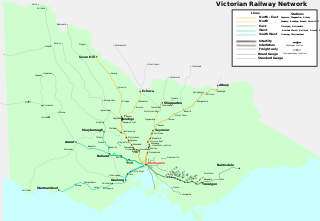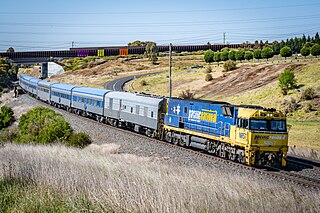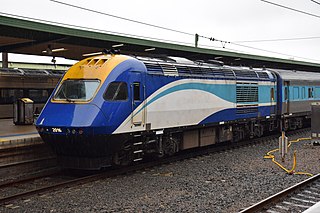
The 4D was a prototype double deck electric multiple unit built for the Public Transport Corporation in Victoria, Australia, for operation on the Melbourne railway system. It remains the only double deck train to have ever operated in Melbourne. The train's name stood for "Double Deck Development and Demonstration."

Rail transport in the Australian state of Victoria is provided by a number of railway operators who operate over the government-owned railway lines. The network consists of 2,357 km of Victorian broad gauge lines, and 1,912 km of standard gauge freight and interstate lines; the latter increasing with gauge conversion of the former. Historically, a few experimental 762 mm gauge lines were built, along with various private logging, mining and industrial railways. The rail network radiates from the state capital, Melbourne, with main interstate links to Sydney and to Adelaide, as well as major lines running to regional centres, upgraded as part of the Regional Fast Rail project.

The Hitachi was an electric multiple unit that operated on the Melbourne suburban railway network between 1972 and 2014. Electrical equipment was supplied by Commonwealth Engineering to designs by Hitachi of Japan, leading to their official name today, though no actual Hitachi-supplied components were used in their construction. They were the last suburban trains in Melbourne with no air conditioning. A total of 355 carriages were built between 1972 and 1981, including a replacement carriage for one written off while the fleet was still being delivered.

The Overland is an interstate passenger train service in Australia, travelling between the state capitals of Melbourne and Adelaide, a distance of 828 km (515 mi). It first ran in 1887 as the Adelaide Express, known by South Australians as the Melbourne Express. It was given its current name in 1936. Now operated by private company Journey Beyond, the train undertakes two return trips a week. Originally an overnight train that stopped at large intermediate stations, it now operates during the day, stopping less frequently.
The South Gippsland railway line is a partially closed railway line in Victoria, Australia. It was first opened in 1892, branching from the Orbost line at Dandenong, and extending to Port Albert. Much of it remained open until December 1994. Today, only the section between Dandenong and Cranbourne remains open for use. The section of the line from Nyora to Leongatha was used by the South Gippsland Tourist Railway until it ceased operations in 2016. The section from Nyora to Welshpool, with extension trail to Port Welshpool and a portion of the former line at Koo Wee Rup, have been converted into the Great Southern Rail Trail.
The North East railway line is a railway line in Victoria, Australia. The line runs from Southern Cross railway station on the western edge of the Melbourne central business district to Albury railway station in the border settlement of Albury-Wodonga, serving the cities of Wangaratta and Seymour, and smaller towns in northeastern Victoria.

Swan Hill railway station is located on the Piangil line in Victoria, Australia. It serves the town of Swan Hill, and it opened on 30 May 1890.

Maryborough railway station is located on the Mildura line in Victoria, Australia. It serves the town of Maryborough, and it opened on 7 July 1874.

Melbourne Express was a free newspaper distributed on weekday mornings at railway stations in Melbourne, Australia. It was published by Fairfax Media.

The New South Wales XPT is a class of diesel-powered passenger trains built by Comeng and ABB. Based on the British Rail-designed High Speed Train, each XPT set comprises two XP power cars in a push-pull configuration and, between them, between four and seven passenger carriages.

The Tait trains were a wooden bodied electric multiple unit (EMU) train that operated on the suburban railway network of Melbourne, Victoria, Australia. They were introduced in 1910 by the Victorian Railways as steam locomotive hauled cars, and converted to electric traction from 1919 when the Melbourne electrification project was underway. The trains derived their name from Sir Thomas James Tait, the chairman of commissioners of the Victorian Railways from 1903 to 1910. The first cars were built during 1909 with the last entering service in 1952.

The Mount Buffalo Chalet is an accommodation resort in the Mount Buffalo National Park, the Park administered by Parks Victoria. It is the largest timber building in Australia.

The DRC was a class of railmotor operated by the Victorian Railways on its country rail network in Victoria, Australia. The cars were built by Tulloch Limited in New South Wales, and featured aluminium and steel construction, air-conditioning, and twin diesel engines with hydraulic transmissions.

The Victorian Railways' (VR) Royal Trains operated to transport members of the Royal Family on their numerous tours of Australia on the Victorian rail network. The same carriages were also used for a number of vice-regal trains for the Governor-General of Australia and the Governor of Victoria. The last Royal Train ran in 1988.
The Sydney–Melbourne Express was an overnight intercapital passenger train service that operated between Australia's largest two cities, Sydney and Melbourne, between August 1986 and November 1993. Operated jointly by State Rail Authority and V/Line the name depended on the direction of travel, with the train nicknamed the 'Sex' or 'Mex'.

The Toolamba–Echuca railway is a broad-gauge cross-country rail link between the towns of Toolamba and Echuca in Victoria, Australia. As a railway route to and from Echuca, it provides an alternative to the usual route via Bendigo. The line has not been used for passenger services since 1981, and goods movements on the line are intermittent, with it being booked out of service at times. The line was re-opened for goods traffic while there was track work on the Shepparton line between Seymour and Shepparton. On 3 October 2013 the line was re-opened after an upgrade.
The Webb Dock railway line is a former railway line in Melbourne, Victoria, Australia.

Melbourne tram route 58 is operated by Yarra Trams on the Melbourne tram network from West Coburg to Toorak. The 18.0 kilometre route is operated out of Essendon and Southbank depots with Z, B and E class trams.














